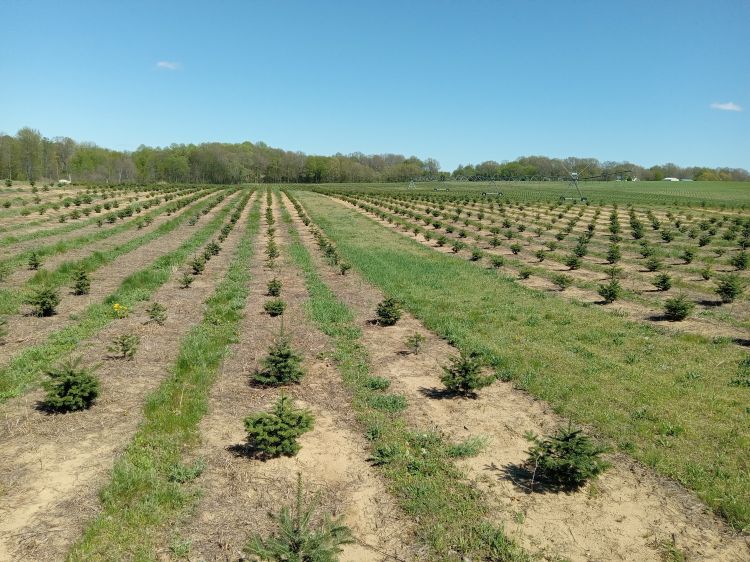Recently labeled herbicide Frequency available for Christmas tree production
Applications of Frequency can improve weed control and prevent weed resistance to other herbicide products.

Weeds can be a significant challenge in Christmas tree production, as they can outcompete trees for water, nutrients and sunlight. From a recent assessment of growers, weed management was the highest rated issue, with 93% of respondents indicating it is an important concern. Weed competition can be mitigated with a variety of control measures including non-chemical means, such as mowing or applying mulch. Nonetheless, using herbicides is one of the most common and potentially effective options (Photo 1) in weed control. The effectiveness of chemical weed control, however, can be impacted by the development of herbicide resistance in certain weed species. This is more likely to occur when the same herbicide is used repeatedly, such as repeated application of glyphosate.
Frequency (topramezone) is a recently labeled herbicide for weed management in Christmas tree production. It has preemergence (PRE) and postemergence (POST) activity on both broadleaf and grassy weeds (Photos 2 and 3). Frequency controls sensitive weeds by inhibiting carotenoid biosynthesis (Group 27), resulting in initially bleached, white weeds (Photo 2) later followed by necrosis and tissue death (Photo 3). This mode of action is unique compared to other herbicides labeled for Christmas tree production.
As with other herbicide products, rotating modes of action between years and applications is useful in preventing a population of weeds from developing resistance to a specific mode of action. It may also be useful in controlling weeds that have developed resistance to other modes of action (e.g., ALS-, EPSPS- and PS II-inhibitor herbicides).
Major broadleaf weeds controlled by Frequency include Canada thistle (seedlings), common lambsquarters, common ragweed, nightshades, marestail, pigweeds and velvetleaf. Grass weeds controlled by Frequency include barnyard grass, fall panicum, foxtails (green and giant) and large crabgrass. Frequency does not have significant nutsedge activity. In weed control experiments in Connecticut by Jatinder Aulakh in 2024, yellow foxtail control with Frequency herbicide was not satisfactory. For effective postemergence control, weeds must be thoroughly covered with herbicide spray as dense leaf canopies shelter small weeds and can prevent adequate control. For effective POST control, broadleaf weeds should be less than 6 inches tall and grassy weeds less than 4 inches tall. Yellow foxtail and fall panicum beyond 4 inches or the four-leaf stage can completely recover from Frequency treatment despite initial 60%-plus bleaching injury.
Frequency label recommends a directed spray and forbids over-the-top applications to avoid injury to Christmas trees. However, in experiments in Connecticut, most species of firs (balsam, Canaan, Fraser and Nordmann), spruces (Colorado blue spruce, Norway spruce) and white pine were highly tolerant to over-the-top applications, with up to twice (8 fluid ounces per acre) the labeled rates. These applications were applied over-the-top about four to five weeks after budbreak. This suggests that, although over-the-top application is precluded by the label, accidental contact with the tree foliage should not result in significant tree injury.
The maximum seasonal use rate for Frequency is 16 fluid ounces per acre and the maximum application rate in an application should not exceed 4 fluid ounces per acre. Therefore, the label allows for four applications (4 fluid ounces per acre, each) per growing season. Frequency has a 30-day interval between re-application and the re-entry interval is 12 hours. Postemergent activity requires an adjuvant for optimal control. The label states to use a methylated seed oil (MSO) or a petroleum based or vegetable seed-based oil concentrate, with an MSO preferred.
Frequency should not be applied when the wind speed exceeds 10 mph or during periods of temperature inversions to avoid spray drifting from treated areas. The spray drift to adjacent crops and vegetation may cause injury.
“Weed Control in Christmas Trees (E3237)” outlines Frequency and other herbicide options. Michigan State University Extension recommends including Frequency as part of your future herbicide plan to improve weed control and prevent weed species from developing resistance to other classes of herbicides.
Always read and follow label instructions. Recommendations in this article do not supersede label instructions.
This work is supported by the Crop Protection and Pest Management Program [grant no 2024-70006-43569] from the USDA National Institute of Food and Agriculture. Any opinions, findings, conclusions, or recommendations expressed in this publication are those of the author(s) and do not necessarily reflect the view of the U.S. Department of Agriculture.



 Print
Print Email
Email

